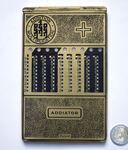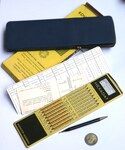


Addiator (Standard model)
Video
Addiator Universal
Hexadat
Video
History
How To Use a Slide Adder
Manuals
Advertisements
Patents
Links
This is one of the earliest models that Addiator produced, a standard 9-column decimal slide adder. It is two-sided, with slides for addition on one side and slides for subtraction on the other. It comes in a leather case that folds open on either side. On the inside cover there are diagonal slots at the corners so that you can insert paper for taking notes. It can be reset by pulling up the bar at the top of the adder.
This exact variant was first produced in about 1923, when the logo consisting of stick figures holding up 010 was added. It is not clear when production of this version ended, but I guess in the 1930s. The serial number is on the clearing bar, and reads M310684.
This is a much later Addiator, the Standard model of the Addiator Universal. It is narrow, with only 6 digits/sliders, and longer because the slots for addition and for subtraction are both on the front of the machine. The register windows are in the middle with the addition slots above and the subtraction slots below. There is no serial number, but this model was made in the 1960s.
This is a Hexadat Addiator, which allows for calculations in hexadecimal (base 16). This was mainly used by computer programmers. It is similar to the Universal above, in that it has addition and subtraction slots on the front. It has two registers however; the main register in the middle, and below the subtraction slots a second register showing the two's complement. Some sources say it was first made in 1967, but it was certainly being sold from 1971 to 1976.
It comes in a nice zippered sleeve, and a stylus that doubles as a mechanical pencil. There is an instruction leaflet, and a card with tables for converting from decimal to hexadecimal and vice versa. Some versions of the Hexadat have such a table on the back, though the back of mine is blank grey.
The slide adder was invented by Claude Perrault in France some time in the second half of the 17th century. His machine was called the "Abaque Rhabdologique". It was however Heinrich Kummer who in the 1840s created the first version where the carry from one digit to the next was performed by moving the stylus around a hook-shaped slot.
Carl Kübler (born 1875 in Stuttgart) was an engineer in the textile industry, who decided to become an entrepreneur. He was looking for things to manufacture, and came across a slide adder called MEUM that was being produced by Otto Meuter since 1918. It was not very successful, so Meuter sold the business and utility patent to Kübler, who then founded Addiator GmbH in 1920. In his hands the Addiator became so successful that soon dozens of different versions appeared on the market. These slide adders offered a relatively cheap aid to calculating sums. These Addiator competitors had names such as the Pocket Adding Machine, Pro Calculo, and Produx (all by Otto Meuter), as well as Correntator, Picma, Ve-Po-Ad (Vest Pocket Adder), Tarema, Baby Calculator, and many, many more.
Carl Kübler's son Hans-Wolfgang became technical lead of the company in 1935, while daughter Margot rose up the ranks in management. By the end of the second world war Carl had retired and Margot was head of the company. Hans-Wolfgang's post-war exploits can be found on the Addimult page. In the 1950s there was a revival in popularity of slide adders, especially in the USA, so Addiator started to export many of them to the USA. Once again many cheap competitors appeared, including from the far East, leading to the company's decline. Nevertheless production continued until the 1970s, after which cheap electronic calculators became the norm. The special non-decimal versions (e.g. Addfeet) held out the longest.
To add a number, you place the stylus in a gap between the teeth of a slider next to a particular
number, and slide the stylus all the way down. This shifts the slider the chosen number of steps,
so that the number shown in that column of the register is increased by that amount.
The sliders generally only slide down at most 9 steps. If adding your chosen digit were to push
it above 9, then a different action is needed. You can recognise this either by the fact that your
stylus doesn't go all the way down, or by the fact that the teeth next to the stylus have a red
dot painted on them. If that is the case, then instead of sliding it down, slide it all the way up,
then move the stylus to the left and then down a bit. These last movements let the stylus engage
with the next column and pull it down one step, thus adding a carry to that next column.
If this method of automatically carrying causes the next column to overflow above 9, then
that is usually visible in the register window as a red dot or red arrow. In this case you will
have to add a 0 to that next column in the normal manner, i.e. put the stylus next to the 0 in that
column, and bring it all the way to the top, and then left and down to carry to the column after that.
If that column overflows too, you have to repeat that action again for the next column, and so on.
Subtraction is essentially the reverse of addition, and can be done by reversing all the actions of addition. All Addiators however have a second set of slots which are used for subtraction, and these are either located below the addition slots or on the back side of the machine. The subtraction slots have 'hooks' at the bottom instead of the top so that you can move your stylus to the bottom and then left and up, to borrow from the next column up.
To clear the register, pull the little bar at the top of the machine. This pulls all the sliders upwards with it, until every digit in the register is zero. Then push the bar back down before starting the next calculation.
Here is a collection of instruction sheets and booklets for various Addiator variants.
Here are a various advertisements and articles from online archives.
| Patent | Filing date | Publish date | Name | Description |
|---|---|---|---|---|
| US 90,275 | 18-05-1869 | 18-05-1869 | Henry Kummer | Slide adder with hooked slots. |
| DE 356,782 | 13-04-1920 | 28-07-1922 | Carl Kübler | Front plate with hook-shaped slots. |
| DE 367,599 | 24-05-1919 | 23-01-1923 | Carl Kübler | Adder with subtraction slots on reverse. See also AT 94,048B, CH 98,349, FR 524,987, GB 148,455, US 1,596,108. |
| DE 368,829 | 06-02-1921 | 10-02-1923 | Carl Kübler | Small strut for holding the guide rails of the sliders. |
| DE 398,772 | 13-04-1920 | 15-07-1924 | Carl Kübler | Extra long sliders with numbers 10 and higher, for easier calculations. |
| DE 405,334 | 02-10-1921 | 03-11-1924 | Carl Kübler | Ribbed or sunken teeth to avoid red markings being rubbed off. |
| DE 408,032 | 23-07-1922 | 08-01-1925 | Carl Kübler | Sliders adapted for weights, times, or Sterling currency. See also GB 201,168. |
| DE 411,751 | 02-10-1921 | 01-04-1925 | Carl Kübler | Alignment mechanism for sliders |
| DE 416,564 | 23-03-1920 | 20-07-1925 | Carl Kübler | Extra long sliders with blanks above 9 and below 0, for easier carry/borrow actions. See also CH 102,321, GB 172,909. |
| DE 586,918(?) | 22-08-1930 | 12-10-1933 | Carl Kübler | Sliders with blanks above 9 and below 0, for easier carry/borrow actions See also CH 163,596, GB 387,728, US 1,961,053. |
| DE 1,387,966U | 24-03-1936 | 22-10-1936 | Carl Kübler | Slide adder that also displays negative numbers. See also AT 131,301B. |
| DE 655,353 | 29-01-1936 | 13-04-1938 | Carl Kübler | Addiator with slide rule |
| US 2,238,529 | 02-05-1939 | 15-04-1941 | Hans-Wolfgang Kübler | Addiator with slide rule |
© Copyright 2025 Jaap Scherphuis, mechcalc a t jaapsch d o t net.